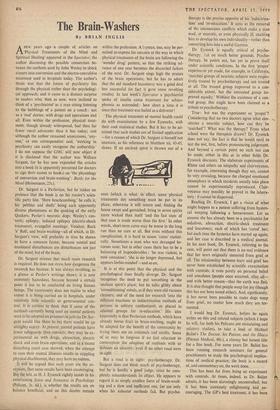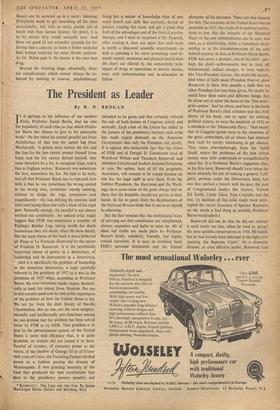The Brain-Washers
By BRIAN INGLIS AFEW years ago a couple of articles on 'Physical Treatments of the Mind and Spiritual Healing' appeared in the Spectator, the author discussing the possible connection be- tween the methods used by John Wesley to shock sinners into conversion and the electro-convulsive treatment used in hospitals today. The author's thesis was that the future of psychiatry lies through the physical rather than the psychologi- cal approach; and it came as a distinct surprise to readers who, then as now, were inclined to think of a `psychiatrist' as a man sitting listening to the babblings of a patient on a couch : not as a 'real' doctor, with drugs and operations and all. Even within the profession, physical treat- ment, though already widespread, had then far fewer vocal advocates than it has today; and although the author remained anonymous, `any- one,' as one correspondent said, `working in psychiatry can easily recognise the authorship.' I do not suppose the GMC will now object if it is disclosed that the author was William Sargant, for he has now expanded -the articles into a book (it is apparently permitted for doctors to sign their names to books) on 'the physiology of conversion and brain-washing' : Battle for the Mind (Heinemann, 25s.).
Dr. Sargant is a Pavlovian, but he makes no pretence that the book is on his master's scien- tific party line. `Mere beachcombing,' he calls it, his `pebbles and shells' being such apparently diverse phenomena as the quaking of the early Quakers; Pavlov's neurotic dogs; Wesley's con- verts; epilepsy; induced epilepsy (electric-shock treatment); evangelist meetings; Voodoo; Rock 'n' Roll; and brain-washing—all of which, in Dr. Sargant's view, will probably in time be shown to have a common factor, because mental and emotional disturbances are disturbances not just of the mind, but of the brain.
Dr. Sargant stresses that much more research is required. He does not stress how dangerous the research has become. It was always revolting, as a glance at Pavlov's writings shows; it is now extremely hazardous, because beyond a certain point it has to be conducted on living human beings. The community does not realise to what extent it is being carried on in hospitals, under relatively little scientific or governmental con- trol. It is curious to think that if some of the methods currently being used on mental patients were to be. adopted on prisoners in jails (as Dr. Sar- gant would like them to be) there would be an almighty outcry. At present, mental patients have fewer safeguards than convicts; they may be ex- perimented on with drugs, abreaction, electric shock and even brain operations; and as a recent disturbing court case showed, when the attempt to cure their mental illnesses results• in crippling physical disablement, they may have no redress.
It will be argued that such cases are the ex- ception; that some results have been encouraging. But the test, as H. J. Eysenck rightly insists in his entertaining ,Sense and Nonsense in Psychology (Pelican, 3s. 6d.), is whether the results are on balance beneficial; and on this doubts remain within the profession. A layman, too, may be per- mitted to express his concern at the way in which physical treatments of the brain are following the `wonder drug' pattern, so that the striking ad- vance of one year becomes the discarded failure of the next. Dr. Sargant sings high the praises of the brain operations; but he has to admit that the old standard leucotomy was a go'od deal less successful (in fact it gave some revolting results). In last week's Spectator a psychiatrist spoke of insulin coma treatment for schizo- phrenia as outmoded : how short a time it is since that treatment was hailed as a deliverer !
The physical treatment of mental health could do with examination by a few Eysencks, with their cool statistical studies. But it has to be ad- mitted that such studies are of limited application —for a reason of which Dr. Sargant is himself not unaware, as his reference to Matthew xii, 43-45, shows. If an unclean spirit is thrown out of a man (which is what, in effect, some physical treatments do) something must be put in its place; otherwise it will return and, finding the house swept and garnished, bring in seven spirits more wicked than itself `and the last state of that man is made worse than the first.' In other words, short-term cures may be worse in the long run than no cure at all. But even without this complication, it is hard to assess 'cures' statisti- cally. Sometimes a man who was deranged be- comes sane; but in other cases there has to be a balancing of imponderables : `he was violent, is now comatose'; `she is no longer depressed, but appears feeble-minded'—and so on.
It is at this point that the physical and the psychological lines finally diverge. Dr. Sargant recognises the need to put something in the unclean spirit's place; but he talks glibly about `reconditioning' minds, as if they were old vacuum cleaners; and of the need for research `into the different reactions to indoctrination methods of persons in solitary confinement, or placed in selected groups for re-education.' His idea apparently is that Pavlovian methods, which have already borne fruit in brain-washing, ought to be adapted for the benefit of the community by trying them out on criminals and misfits. Some of us may be forgiven if we feel reluctant to contemplate the adoption of methods with so dubious an ancestry; even if no other road were in sight.
But a road is in sight : psychotherapy. Dr. Sargant does not think much of psychotherapy, but he is hardly a good judge, since he com- pletely misunderstands its object. He appears to regard it as simply another form of brain-wash- ing and a slow and inefficient one, for use only when his robuster .methods fail. But psycho- therapy is the precise opposite of his `indoctrina- tion' and `re-education.' It aims at the removal of the unconscious conflicts which make a man mad, or neurotic, or even physically ill, enabling him to develop his own individuality—rather than converting him into a useful Gamma.
Dr. Eysenck is equally critical of psycho- therapy; but on much better grounds. Psycho- therapy, he points out, has yet to prove itself under scientific conditions. In the first 'proper' experiment yet made, for example, in California, `matched groups of neurotic subjects were respec- tively treated by psychotherapy and not treated at all. The treated group improved to a con- siderable extent, but the • untreated group im- proved equally.' Without the existence of a con- trol group, this might have been claimed as a tribute to psychotherapy.
True : but was the experiment so `proper'? Considering that no two doctors agree what con- stitutes a neurotic subject, how can they be `matched'? What was the therapy? From what school were the therapists drawn? Dr. Eysenck does not say; the fact is that he would need to test the test, first, before pronouncing judgement. And beyond a certain point no such test can be made; either in this or in other fields Dr. Eysenck discusses. The elaborate experiments of Rhine and others on telepathy and clairvoyance, for example, interesting though they are, cannot be very revealing, because the charged emotional atmosphere in which incidents usually take place cannot be experimentally reproduced. Clair- voyance may possibly be proved in the labora- tory : it cannot be disproved.
Reading Dr. Eysenck, I get a vision of what might happen to a patient suffering from hysteri- cal weeping following a bereavement. Let us assume she has already been to a psychiatrist for sedatives, abreaction, electric-shock treatment and leucotomy, each of which has `cured' her; but each time the hysterics have started up again; and her case is described in a medical journal. In his next book, Dr. Eysenck, referring to the case, will point out that there is no real evidence that her tears originally stemmed from grief at all. The relationship between tears and grief has never been established by scientific examination with controls; it rests purely on personal belief and anecdotes (people once assumed, after all— and with better reason—that the earth was flat). It is also thought that people weep for joy (though this has not been tested either). And, significantly, it has never been possible to make dogs weep from grief, no matter how much they are tor- mented.
I would beg Dr. Eysenck, before he again writes on this and related subjects (which I hope he will, for both his Pelicans are stimulating and salutary studies), to take a look at Michael Balint's The Doctor, his Patient, and the Illness (Pitman Medical, 40s.), a clumsy but honest title for a fine book. For some years Dr. Balint has been running research seminars for general practitioners to study the psychological implica- tions of medical practice; the book is a record of, and commentary on, the work done.
This has been far from being an experiment with controls. At times, indeed, as Dr. Balint admits, it has been alarmingly uncontrolled; but it has been extremely enlightening and en- couraging. The GP's best treatment, it has been found, can be summed up in a word : listening. Everybody needs to get something off his chest occasionally; and with so many people out of touch with their former listener, the priest, it is to the doctor they would normally turn. And there are good (if not scientific) grounds for be- lieving that a capacity to listen is better medicine than bottled medicine for most chronic patients. As Dr. Balint puts it, the doctor is his own best drug.
Beyond the listening stage, admittedly, there arc complications which cannot always be re- moved by training or courses, psychotherapy being less a matter of knowledge than of per- sonal hunch and skill. But anybody, doctor or patient, reading this book will get a good idea both of the advantages and of the risks of psycho- therapy; and I shall be surprised if Dr. Eysenck, after reading it, does not agree that such work is worth a thousand scientific experiments—as well as pointing a far more promising road to- wards mental, emotional and physical health than the short cut offered by the melancholy tech- niques of drugs or operations or electric shocks, even with indoctrination and re-education to follow.



































 Previous page
Previous page